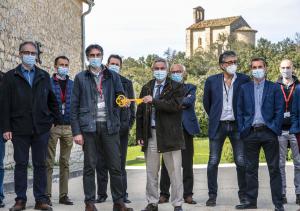A place to meet
Four months later, the COVID pandemic struck, imposing limitations on gatherings and travel. What had been a simple need to facilitate team cohesion and communication within the JT-60SA project now became a necessity for the broader worldwide fusion community.
The remote experiment centre now exists. It is located in a renovated building on the vast domain of Château de Cadarache, a few kilometres from the ITER site. On Friday 12 March, the French Alternative Energies and Atomic Energy Commission (CEA), which provided the building, handed over a symbolic key to the Institute for Magnetic Fusion Research (IRFM) which will operate it.
The 300 m² facility will comprise a large "participation room," along with meeting spaces that are fully equipped with giant screens and sophisticated communication tools. "The remote experiment centre originated from the needs of the JT-60SA teams," explains Frédéric Imbeaux, the head of the Fusion Plasma Physics Department at EUROfusion. "But we will be able to use it for collaborating with EAST and HL-2M in China, DIII-D in the United States, JET in the United Kingdom, and of course IRFM and ITER. We have also entered discussions with the Fusion Department at Aix-Marseille University. This tool can contribute to establishing the fusion community of tomorrow."


